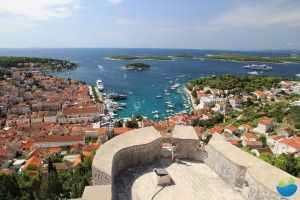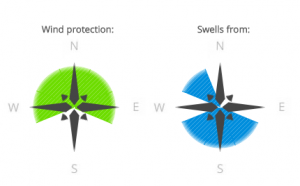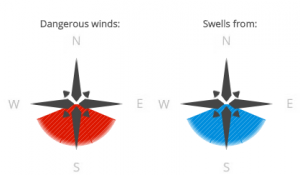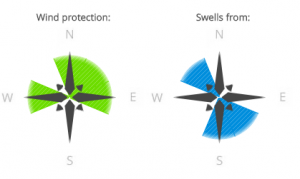
If you ask insider about places to be during your Croatia trip, Hvar is mentioned almost all the time. In the small and picturesque town live about 4.000 people and it is located at the south west side of the island Hvar in a sheltered bay. Approaching the island the first thing you will notice is the Spanish fortress of the 13th century high above the city. It takes a sweaty walk of about 20 minutes to get there. Instead you’ll be rewarded with a stunning view over the harbour, the city and the close-by Pakleni islands.
Hvar became quite a hotspot in the last couple of years. Not only Croatian stars are well seen visitors, but also international jetset have spotted the neat city. That is why in Hvar costs are higher than anywhere else in Croatia. That includes anchorage as well as a visit in the several restaurants and bars. Of course there are also good restaurants with more decent prices.
The most beautiful view of the city you’ll get from the sea. Standing on the yacht you’ll get an impressive view of the water front lined with palm trees and the ancient 700 years old defence walls all up the hill to the fortress Španjol of the 16th century. Above this fortress there is the French, in 1811 built fortress Napoleon. Today it’s used for mobile communication installations. The most important monasteries and churches originate from the bloom of the island during the Venetian governance from 15th to 18th century. Back then the island was a very important trading base in the eastern Adriatic region. Where back in the days the Venetian navy stayed during winter you can see nowadays shiny polished super yachts.

The mixture of super yachts, cruisers, sailing yachts, motorboats, rips, dinghies, jet skis, ferries, taxi boats, and SUP’s (Stand Up Paddling) is pretty unique. Motors scream, chains rattle, people laugh. The traffic in the port basin and therefore the swell is remarkable. On some days you can count about 100 yachts in the harbour. And all of them came to enjoy the glamourous flair of the city.
And there’s a lot of flair in Hvar. Straight to the central place with its smooth polished stones there’s one of Europe’s oldest theatres.

Today you can visit a small exhibition and the museum in there.
Alongside the central place you will find many different restaurants and bars, inviting to linger. At the end of the central place is the farmers’ market where you can purchase fresh fruit and vegetables, fish and bread. Also there is a larger supermarket in the nearby area.
The problem is to find a berth in Hvar. Following we describe five possible places to berth your yacht.
Berth possibilities in the harbour of Hvar:
1) At city quay with mooring-lines, electricity and fresh water. But city quay is mostly completely taken and smaller yachts have hardly a chance to get a free spot. A reservation by phone with suitable extra charge will help.
2) In the western part of the harbour bay you’ll find 6 single buoys where you can moore by rope.

3) There’s another buoy field in the south western part of the bay. Several yachts share one buoy by mooring by bow-line. Also they have to fix their yacht by land-line on the shore. If strong winds come in from north or south the maneuver requires quick coordination of the crew. Both, bow-line and land-line have to be banked quickly.

4) You can anchor in 12-18 meters depth (39-59 ft.) if your anchor chain is long enough and if there’s no wind from the south. If so, you have to leave the place. It’s located in south-western direction of the buoy fields.

5) In the nearby area of the harbour there are several other possibilities to anchor (e.g. Marinkovac) or the ACI-Marina Palmizana on Sv. Klement. Taxi boats leave regularly to Hvar.









